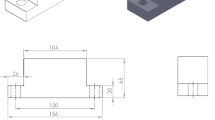Abstract
Removing material efficiently in end milling usually involves taking a width of cut equal to the cutter diameter, i.e., to mill in full slotting as much as possible. However, in this case, end mills are very sensitive to the effects of cutting forces. Cutter deflection and vibrations may become limiting factors, especially at high machining rates and with long overhangs. To overcome these constraints, a new machining method to end mill workpieces can be considered. It is called “balancing of the transversal cutting force” (BotTCF). Indeed, this new machining method allows us to reduce deflection and vibrations and can therefore increase productivity. All the existing studies have used toroidal cutters with round inserts. Hence, the present study will focus on the application of the BotTCF to pocket milling cutters, considering their much more complex geometry. The goal is to determine the optimal inclination of the cutter axis, so as to minimize the transversal cutting force. In order to find this optimal inclination, a new cutting force model has been developed tailored to the pocket milling cutters. Then the BotTCF methodology has been applied to this type of cutter. An experimental validation has been carried out, and results validate the overall approach.
Similar content being viewed by others
References
Gok A, Gologlu C, Demirci HI (2013) Cutting parameter and tool path style effects on cutting force and tool deflection in machining of convex and concave inclined surfaces. Int J Adv Manuf Technol 69(5–8):1063–1078
Wang L, Chen ZC (2014) A new CAD/CAM/CAE integration approach to predicting tool deflection of end mills. Int J Adv Manuf Technol 72(9–12):1677–1686
Bhattacharya A, Bera TK, Thakur A (2015) On cutter deflection profile errors in end milling: modeling and experimental validation. Mater Manuf Process 30(8):1042–1059
Shorr MJ, Liang SY (1996) Chatter stability analysis for end milling via convolution modelling. Int J Adv Manuf Technol 11(5):311–318
Sivasakthivel PS, Velmurugan V, Sudhakaran R (2010) Prediction of vibration amplitude from machining parameters by response surface methodology in end milling. Int J Adv Manuf Technol 53(5–8):453–461
Hense R, Wels C, Kersting P, Vierzigmann U, LÃűffler M, Biermann D, Merklein M (2014) High-feed milling of tailored surfaces for sheet-bulk metal forming tools. Prod Eng 9(2):215–223
Damir A, Ng Eu-Gene, Elbestawi M (2010) Force prediction and stability analysis of plunge milling of systems with rigid and flexible workpiece. Int J Adv Manuf Technol 54(9-12):853–877
Rauch M, Hascoet J-Y (2012) Selecting a milling strategy with regard to the machine tool capabilities: application to plunge milling. Int J Adv Manuf Technol 59(1-4):47–54
Danis I, Monies Frédéric, Lagarrigue P, Wojtowicz N (2015) Cutting forces and their modelling in plunge milling of magnesium-rare earth alloys. Int J Adv Manuf Technol:1–20
Gilles P, Monies F, Rubio W (2007) Optimum orientation of a torus milling cutter: method to balance the transversal cutting force. Int J Mach Tools Manuf 47(15):2263–2272
Gilles P, Cohen G, Monies F, Rubio W (2008) Dynamic behaviour improvement for a torus milling cutter using balance of the transversal cutting force. Int J Adv Manuf Technol 40(7-8): 669–675
Gilles P, Cohen G, Monies F, Rubio W (2012) Torus cutter positioning in five-axis milling using balance of the transversal cutting force. Int J Adv Manuf Technol 66(5-8):965–973
Gilles P, Cohen G, Monies F, Rubio W (2014) Machining strategy in five-axis milling using balance of the transversal cutting force. Int J Adv Manuf Technol 72(9-12):1377–1387
Moussaoui K, Monies F, Mousseigne M, Gilles P, Rubio W (2015) Balancing the transverse cutting force during inclined milling and effect on tool wear: application to Ti6al4v. Int J Adv Manuf Technol:1–22
Koenigsberger F, Sabberwal AJP (1961) An investigation into the cutting force pulsations during milling operations. International Journal of Machine Tool Design and Research 1(1-2):15–33
Yucesan G, Altintas Y (1996) Prediction of ball end milling forces. J Eng Ind 118(1):95–103
Gilles P, Monies F, Rubio W (2006) Modelling cutting forces in milling on torus cutters. Int J Mach Mach Mater 1(2):166–185
Mahmud A, Mayer JRR, Baron L (2015) Determining the minimum clamping force by cutting force simulation in aerospace fuselage pocket machining. Int J Adv Manuf Technol 80(9-12):1751–1758
Danis I, Wojtowicz N, Monies F, Lamesle P, Lagarrigue P (2013) Cutting conditions and surface integrity during dry plunge-milling of a wrought magnesium alloy. Procedia Engineering 63:36–44
Danis I, Wojtowicz N, Monies Frédéric, Lagarrigue P (2014) Influence of dry plunge milling conditions on surface integrity of magnesium alloys. International Journal of Mechatronics and Manufacturing Systems 7 (2-3):141–156
Wojciechowski S (2015) The estimation of cutting forces and specific force coefficients during finishing ball end milling of inclined surfaces. Int J Mach Tools Manuf 89:110–123
Wojciechowski S, Chwalczuk T, Twardowski P, Krolczyk GM (2015) Modeling of cutter displacements during ball end milling of inclined surfaces. Archives of Civil and Mechanical Engineering 15(4):798–805
Author information
Authors and Affiliations
Corresponding author
Rights and permissions
About this article
Cite this article
Monies, F., Danis, I., Lagarrigue, P. et al. Balancing of the transversal cutting force for pocket milling cutters: application for roughing a magnesium-rare earth alloy. Int J Adv Manuf Technol 89, 45–64 (2017). https://doi.org/10.1007/s00170-016-9011-8
Received:
Accepted:
Published:
Issue Date:
DOI: https://doi.org/10.1007/s00170-016-9011-8




